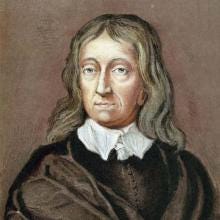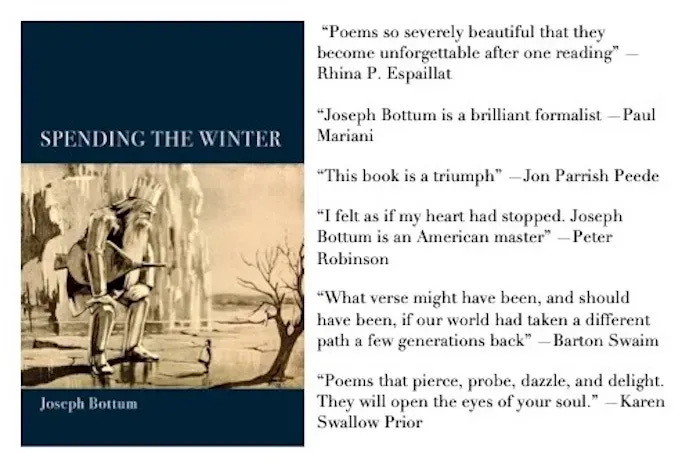
Divine Epigrams
by Richard Crashaw
The Widow’s Mites Two mites, two drops, yet all her house and land, Fall from a steady heart, though trembling hand: The other’s wanton wealth foams high, and brave; The other cast away, she only gave. On the Prodigal Tell me, bright boy, tell me, my golden lad, Whither away so frolic? why so glad? What all thy wealth in council? all thy state? Are husks so dear? troth ’tis a mighty rate. To our Lord, upon the Water made Wine Thou water turn’st to wine, fair friend of life ; Thy foe, to cross the sweet arts of Thy reign, Distils from thence the tears of wrath and strife, And so turns wine to water back again. On the Sepulcher of Our Lord Here, where our Lord once laid his Head, Now the grave lies burièd. ═══════════════════════
The epigram, wrote Joseph Bottum in this space last year, doesn’t lend itself readily to English. Or perhaps it’s just that English doesn’t lend itself readily to the form of the epigram. Nevertheless,
the resistance of the language never stopped English poets from producing epigrams, particularly during the centuries when poets were schooled in classical languages. Nearly all major poets have turned their hands to the form, from the eighteenth-century Alexander Pope — who wrote the inscription for the collar of the prince’s pet: I am His Highness’s dog at Kew. / Pray tell me, Sir, whose dog are you? — to the twentieth-century William Butler Yeats, who wrote, for a fellow Irish literary figure, “To a Poet, Who Would Have Me Praise Certain Bad Poets, Imitators of His and Mine”: You say, as I have often given tongue / In praise of what another’s said or sung, / ’Twere politic to do the like by these, / But was there ever dog that praised his fleas?
It is a form congenial to poets whose natural bent is for concision and the transparency that makes a poem look easy though it is in fact extremely difficult . . .
This brings us to Richard Crashaw (1613–1649). Crashaw numbers among the metaphysical poets of seventeenth-century England, whose company also includes George Herbert, John Donne, and Henry Vaughan. Like Herbert, and in a reversal of Donne’s trajectory, Crashaw began as a High-Church Anglican — though his father had been a Puritan-leaning Anglican divine who published pamphlets decrying the evils of popery — educated at the Charterhouse School and Pembroke College, Cambridge, and serving as a Fellow at Peterhouse College, Cambridge.
Though no records exist to verify this significant segment of his biography, he is generally said to have received holy orders in the Church of England, and to have served as vicar at the Church of Saint Mary the Less, colloquially known as Little Saint Mary’s, adjacent to Peterhouse in Cambridge. In any event, on Oliver Cromwell’s seizure of the city in 1643, Crashaw found himself exiled from Cambridge and took refuge on the Continent. During his period of exile, possibly while in the Netherlands, he converted to Roman Catholicism before dying, in Loreto, Italy, at the age of 37.

His poems, meanwhile, like those of his better-known Metaphysical contemporaries, delight in opposition and paradox. But as Victoria Moul has noted, “By far the most popular Latin verse form in the sixteenth and seventeenth century was the epigram.” When Crashaw is remembered, it is chiefly as a practitioner of this verse form. His Steps to the Temple, a collection of sacred poems published in 1646, contains over 550 epigrams that distill scriptural narratives into rhymed couplets and quatrains.
Here we see a small selection of those distillations. These four tiny poems showcase the poet’s savor for juxtaposition and reversal: the widow with the profligate rich man, the Prodigal Son who gives all his inheritance for pig feed, the devil who turns joy to tears, the Lord’s tomb which entombs death itself.
Like Herbert — the near contemporary to whom the title of Crashaw’s book most obviously invites comparison — Crashaw was interested in metrical play and variation, as in this extended meditation on a tear falling from the eye of the Blessed Virgin Mary. But in the Divine Epigrams, the poet’s mind funnels itself into an act of extreme compression, which among other things entails making as much of the available space as possible.
Lines in iambic pentameter allow for some range of motion, to encapsulate a narrative and uncover a meaning in that narrative. The epigram on the widow’s mite juxtaposes two couplets, one about the widow, the other about the rich man, as though to highlight in one brief verse the separation of the two moral realities these characters inhabit. “On the Prodigal,” an abab quatrain, functions as an examination of conscience — if the boy’s father had cared to question him.
The third epigram in this selection, “To Our Lord, upon the Water Made Wine,” draws on the narrative of the miracle at Cana, found in the second chapter of St. John’s Gospel. But what this abab quatrain becomes, in its brevity, is a homily on Satan’s power and its limits: evil cannot make, but only unmake. It reverses joy, turning it to tears, but this is not the same thing as creating sorrow. Again, juxtaposition implies this argument without making it explicitly. What God does, God’s opposite and opponent can only undo. And even that, as the entwined rhymes suggest, is bound up in the all-sufficiency of God. In contrast with the widow and the rich man of the first epigram, each portrayed in a couplet, in this poem there simply is no separate power.
The last epigram, and the pithiest, is in tetrameter. Where Pope’s tetrameter couplet about “His Highness’s dog at Kew,” written nearly a century later, is unforgettably witty, this tetrameter couplet simmers down Christian theology into two incontrovertible lines, whose meter, each line ending on an iamb, emphasizes the past-tenseness of death in that theology. “Now the grave lies buriéd.”
All these poems are so brief as to seem tossed off, like afterthoughts. Yet in their compressed sophistication of thought and form — given how difficult the epigram is to render in English, even when everyone’s doing it — they are miracles of poetic achievement for which Crashaw deserves to be remembered and honored.






Not a poet known for concision and discipline but traditionally known and dismissed for prodigality, emotionalism, and excess; witness Douglas Bush’s devastating witticism (channeling Lear): “With Crashaw over-ripeness is all.” But as you well demonstrate, Crashaw has a deep religious sensibility, considerable skill, and deserves another look. Though Catholic for only the last years of his life, the linked poem on the Virgin Mary along with his translation of Stabat Mater Dolorosa and other works show a life-long devotion to the Virgin; he also venerated the saints in famous works, especially Mary Magdalen (“The Weeper”) and Teresa of Avila (“The Flaming Heart”). “The Hymn to the Name of Jesus” is a symphonic masterpiece. A skilled epigrammatist, yes, but also, paradoxically, an English Catholic Baroque poet—"profuse in imagery, abundant in theatrical emotion, and rich in intellectual energy."
We live in a world bounded by data streams and anime, with lashings of pornography of (both the violent and venereal sort): Crashaw is a good exit, or at least he can push the door ajar.